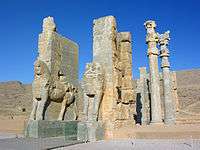Nasrid dynasty (Sistan)
| Nasrid dynasty of Sistan | ||||||||||||
| Kingdom | ||||||||||||
| ||||||||||||
|
| ||||||||||||
| Capital | Zaranj | |||||||||||
| Languages | Persian | |||||||||||
| Religion | Sunni Islam | |||||||||||
| Political structure | Kingdom | |||||||||||
| Malik | ||||||||||||
| • | 1029–1073 | Tadj al-Din I Abu l-Fadl Nasr | ||||||||||
| • | 1106-1164 | Taj al-Din II Nasr ibn Khalaf | ||||||||||
| • | 1169–1213 | Taj al-Din III Harb ibn Muhammad ibn Nasr | ||||||||||
| • | 1213–1221 | Yamin al-Din Bahram Shah ibn Harb | ||||||||||
| Historical era | Middle Ages | |||||||||||
| • | Established | 1029 | ||||||||||
| • | Disestablished | 1225 | ||||||||||
| Currency | billon Dirhem | |||||||||||
| ||||||||||||
| Today part of | Countries today
| |||||||||||
 | ||||||||||||||||||||||||||||||||||||||||||||
| History of Afghanistan | ||||||||||||||||||||||||||||||||||||||||||||
|---|---|---|---|---|---|---|---|---|---|---|---|---|---|---|---|---|---|---|---|---|---|---|---|---|---|---|---|---|---|---|---|---|---|---|---|---|---|---|---|---|---|---|---|---|
| Timeline | ||||||||||||||||||||||||||||||||||||||||||||
|
Ancient
|
||||||||||||||||||||||||||||||||||||||||||||
|
Medieval
|
||||||||||||||||||||||||||||||||||||||||||||
|
Modern
|
||||||||||||||||||||||||||||||||||||||||||||
| ||||||||||||||||||||||||||||||||||||||||||||
The Nasrid dynasty, also referred to as the Later Saffarids of Seistan or the Maliks of Nimruz, was an Islamic dynasty that ruled Sistan in the power vacuum left by the collapse of the Ghaznavid Empire and until the Mongol invasion of Central Asia. The Nasrids were a branch of the Saffarid dynasty, and the establishment of the Nasrid Kingdom at Nimruz in 1068 until its dissolution in 1225 represents a transient resurgence of Saffarid rule in Sistan.[1]
The kingdom was established by Tadj al-Din I Abu l-Fadl Nasr who was the Malik of Sistan under the Ghaznavids. Nasrid maliks ruled intermittently as sovereigns or vassals of larger neighboring powers, including the Seljuks, the Ghurids, and the Khwarezmians. After the dissolution of the kingdom by Inaltigin Khwarazmi[2] in the wake of the Mongol invasion, the region was ruled by a third dynasty of Saffarids, the Mihrabanids.
Nasrid maliks
| Throne Name | Original Name | Portrait | Title | Born-Died | Entered office | Left office | Family Relations | Note | |
|---|---|---|---|---|---|---|---|---|---|
| Nasrid dynasty,[2] 1029-1225 | |||||||||
| 1 | Tadj al-Din I Abu l-Fadl Nasr | Malik | 1029 | 1073 | Malik of Sistan under the Ghaznavids | ||||
| 2 | Baha al-Dawala Tahir ibn Nasr | Malik | 1073 | 1088 | son of Tadj al-Din I Nasr | ||||
| 3 | Badr al-Dawala Abu ‘l-‘Abbas ibn Nasr | Malik | 1088 | 1090 | son of Tadj al-Din I Nasr | ||||
| 4 | Baha al-Dawala Khalaf ibn Nasr | Malik | 1090 | 1106 | son of Tadj al-Din I Nasr | ||||
| 5 | Taj al-Din II Nasr ibn Khalaf | Malik | 1106 | 1164 | son of Baha al-Dawala Khalaf | ||||
| 6 | Taj al-Din II Nasr ibn Khalaf | Malik | 1164 | 1169 | son of Baha al-Dawala Khalaf | ||||
| 7 | Taj al-Din II Nasr ibn Khalaf | Malik | 1106 | 1164 | son of Baha al-Dawala Taj al-Din II Nasr | ||||
| 8 | Taj al-Din III Harb ibn Muhammad ibn Nasr | Malik | 1169 | 1213 | grandson of Tadj al-Din I Nasr | Vassal to the Ghurids | |||
| 9 | Yamin al-Din Bahram Shah ibn Harb | Malik | 1213 | 1221 | son of Taj al-Din III Harb | Killed during the Mongol invasion, ushering in a period of succession instability and subsequent dissolution. | |||
| 10 | Taj al-Din IV Nasr ibn Bahram Shah | Malik | 1221 | 1221 | son of Bahram Shah | ||||
| 11 | Shihab al-Din Mahmud I ibn Harb | Malik | 1221 | 1225 | son of Taj al-Din III Harb | ||||
| 12 | Rukn al-Din Mahmud ibn Bahram Shah | Malik | 1221 | 1222 | son of Bahram Shah | ||||
| 13 | Abu ‘l-Muzaffar Ali ibn Harb | Malik | 1222 | 1222 | son of Taj al-Din III Harb | ||||
| 14 | Ala al-Din Ahmad ibn Uthman Nasr al-Din ibn Harb | Malik | 1223 | 1223 | son of Taj al-Din III Harb | ||||
| 15 | Uthman Shah ibn Uthman Nasr al-Din ibn Harb | Malik | 1225 | 1225 | son of Taj al-Din III Harb | ||||
See also
References
- ↑ Mitchiner, Michael (1977). Oriental Coins and Their Values: The world of Islam. Hawkins Publications. p. 152. ISBN 978-0904173154.
- 1 2 Clifford Edmund Bosworth (January 1996). The New Islamic Dynasties. Columbia University Press. pp. 211–. ISBN 978-0-231-10714-3.

